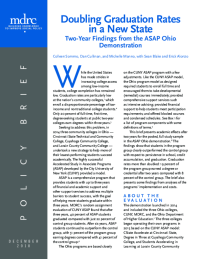Rare example of a program model being successfully adapted in a different setting
Doubling Graduation Rates in a New State
Two-Year Findings from the ASAP Ohio Demonstration

While the United States has made strides in increasing college access among low-income students, college completion has remained low. Graduation rates are particularly low at the nation’s community colleges, which enroll a disproportionate percentage of low- income and nontraditional college students. Only 20 percent of full-time, first-time, degree-seeking students at public two-year colleges earn degrees within three years.
Seeking to address this problem, in 2014 three community colleges in Ohio — Cincinnati State Technical and Community College, Cuyahoga Community College, and Lorain County Community College — undertook a new strategy to help more of their lowest-performing students succeed academically. The highly successful Accelerated Study in Associate Programs (ASAP) developed by the City University of New York (CUNY) provided a model.
ASAP is a comprehensive program that provides students with up to three years of financial and academic support and other support services to address multiple barriers to student success, with the goal of helping more students graduate within three years. MDRC’s random assignment evaluation of CUNY ASAP found that after three years, 40 percent of ASAP students graduated compared with just 22 percent of control group students. After six years, ASAP students continued to outperform the control group, with 51 percent of the program group earning degrees compared with 41 percent of the control group.
The Ohio programs are based closely on the CUNY ASAP program with a few adjustments. Like the CUNY ASAP model, the Ohio program model as designed required students to enroll full time and encouraged them to take developmental (remedial) courses immediately; provided comprehensive support services such as intensive advising; provided financial support to help students meet participation requirements; and offered blocked courses and condensed schedules.
This brief presents academic effects after two years for the pooled, full study sample in the ASAP Ohio demonstration. The findings show that students in the program group clearly outperformed the control group with respect to persistence in school, credit accumulation, and graduation. Graduation rates more than doubled: 19 percent of the program group earned a degree or credential after two years compared with 8 percent of the control group. The brief also presents some findings from analyses of the programs’ implementation and costs.






